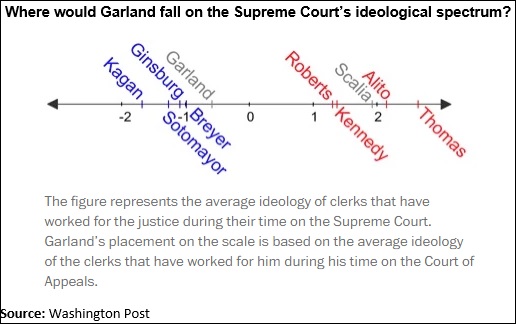New data analysis shows that Merrick Garland would be the Supreme Court’s median justice if he joined the court: To the right of the court’s four liberal justices, and to the left of the four conservative justices.
That said, Garland wouldn’t exactly be a swing vote. He clearly leans toward the left side of the court and would likely agree with Justices Stephen Breyer, Ruth Bader Ginsburg, Elena Kagan and Sonia Sotomayor more often than not.

The new analysis is published in the Washington Post’s Monkey Cage blog by five academics: Adam Bonica with Stanford, Adam Chilton with University of Chicago, Jacob Goldin with Stanford, Kyle Rozema with Northwestern University and Maya Sen with Harvard.
The late Justice Antonin Scalia was the court’s third-most-conservative justice. “Clearly, Garland’s nomination would shift the court — and the court’s median ideology — significantly to the left,” the authors write. “But based on the clerks he has hired, there is good reason to think that Garland is not as liberal as some believe and would in fact be the most moderate member of the court’s liberal bloc.”
Interestingly, the authors conducted their analysis by measuring the ideology of the clerks each justice hired. A given clerk’s ideology was estimated by analyzing campaign donations. As a federal appellate judge, Garland would have hired four clerks per year, or approximately 72 clerks combined over his 18 years as an appellate judge. That provides a fairly sizeable sample to measure Garland’s ideology, assuming he hired clerks whose legal outlook agreed with his.
There is some concern judges might hire more ideologically extreme clerks once they reach the Supreme Court, but the authors analyzed the rise of Justices Samuel Alito and Sotomayor to the Supreme Court from appellate courts and found little difference between the clerks hired before and after their promotion to the Supreme Court.
“Our research shows a strong correlation between this ideology measure and other existing measures for Supreme Court justices, which adds credibility to our assumption that clerk ideology sheds light on that of their hiring judges. And although other credible measures of Supreme Court ideology already exist, an important feature of our approach is that it can be applied to lower-court judges as well, including Garland.”
Jason Russell is a commentary writer for the Washington Examiner.
